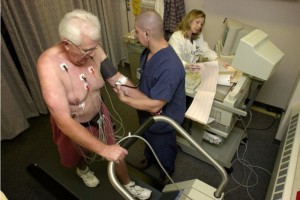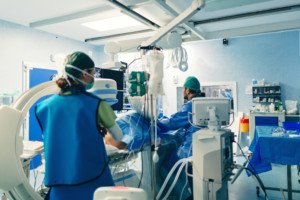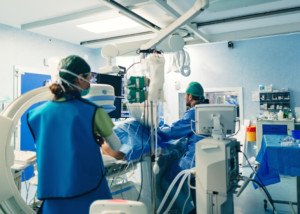
New research shows that the stress test is not effective at detecting obstructive heart disease, and that the CT angiogram wins considerably.
The CT angiogram wins out over the cardiac stress test when it comes to detecting blockages in coronary arteries that can necessitate medical intervention such as bypass surgery.
Beaumont Health System cardiologists led an investigation, and the report is in the Feb. 14, 2012 Journal of the American College of Cardiology.
A CT angiogram is an imaging study of blood vessels using a CAT scanner. The CT angiogram is non-invasive, as is the cardiac stress test.
If serious coronary blockage is detected via either of these means, the next step is the cardiac catheterization procedure, which is highly invasive.
My mother had this performed, and the consent form included generous language describing possible risks, which include heart attack and stroke.
The cath procedure is the gold standard for identifying coronary artery blockage (severe heart disease), but something must lead to this procedure in the first place.

Catheter angiogram. Shutterstock/MAD.vertise
In the case of my mother, an “abnormal” echocardiogram was the preceding test; her cardiologist skipped the CT angiogram and stress test altogether. However, usually, it’s a stress test or CT angiography that precedes.
The Beaumont study showed that the CT angiogram is very effective at detecting obstructive heart disease (blocked arteries) — to the point that the patient must then undergo the cath procedure.
The study also showed that stress tests were not effective.
The Beaumont study examined 6,000 patients who underwent CT angiograms after a stress test.
“We concluded that CT imaging works very well as a ‘gatekeeper’ to the catheterization lab, and can help rule out patients who don’t require invasive coronary angiography,” says Kavitha Chinnaiyan, MD, Beaumont’s director of Advanced Cardiac Imaging Education, in a press release on the Beaumont Health System Web site.
The Beaumont study says that up to 10 percent of stress tests are inconclusive, and thus, lead to the risky cath procedure, which then often turns out to reveal no blockages.
The National Cardiovascular Data Registry of 400,000 patients reports that obstructive heart disease is present in only one third of patients undergoing the cath procedure (also known as invasive cardiac angiography).
The Beaumont study showed that stress tests failed to predict coronary artery obstruction.
The CT angiogram (i.e., with the CAT scanner) correlated nicely with the cath procedure findings, but the cardiac stress test did not.
“Our study shows that CT angiography can help to identify patients who need expensive, invasive testing, especially in patients with inconclusive stress test results,” says Dr. Chinnaiyan in the press release.













